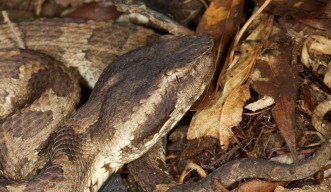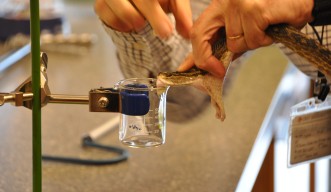Biting into Snake Venom Mysteries
Okinawa is home to two native species of pit viper, the Okinawa Habu and the Himehabu (princess-habu). Like all snake venoms, Habu and Himehabu venoms are complex mixtures of proteins and bio-organic molecules that immobilize prey. Each species has a unique venom composition that reflects its evolutionary origins and ecology. Adult Habus feed mostly upon mammals while Himehabus remain frog eaters throughout life. The Habu is Japan’s largest venomous snake, reaching lengths of 2.5 m, and it is also the most dangerous snake in Japan. Habu venom rapidly perforates blood vessels, causing profound hemorrhage. It immediately stops blood clotting and destroys tissues and cells, commencing prey digestion even while the prey is still alive. On the other hand, the Himehabu reaches only about 80 cm and has much less toxic venom.
Although the proteins comprising venom are designed to kill prey, the proteins can be useful for human medicine at times; one molecule from a Brazilian pit viper venom provided the structure for development of the two most successful anti-hypertensive drugs.
Experts with markedly different specialties worked closely at OIST to characterize the venoms of the Habu and Himehabu. In a paper published in BMC Genomics on November 14th, Dr. Steven Aird, Prof. Alexander Mikheyev, and collaborators reported that venom compositions of the two snakes were considerably different, and they also sequenced some proteins from these venoms that previously had been unknown in snakes.
The biggest innovation of the current study is that, for the first time, a strong correlation between transcriptomes and proteomes were demonstrated. Transcriptomes comprise all the mRNAs, which encode proteins to be synthesized. Proteomes, on the other hand, embrace all the proteins being synthesized in a cell at any given time. Previous studies relied on indirect data from transcriptomes, since this technique provided more information about the abundance of each protein . To obtain RNA data, however, venom glands have to be dissected out of the snake.
In contrast to the previous method, using data from the proteome is non-invasive, requiring only the venom itself, which snakes synthesize as needed, as humans do saliva. The proteome is analyzed using mass spectrometry. Mass spectrometry separates fragments of proteins and determines their amino acid sequences, creating a profile of the types and concentrations of proteins present. Though mass spectrometry had been used before to obtain data about the types of proteins present, it was unable to provide the quantity data. OIST’s state-of-the-art mass spectrometry equipment and the skills of the mass spectrometry technicians in the OIST Biology Resources Section, however, enabled this to be accomplished.
The correlation between the transcriptome and the proteome confirm that proteomic data can be employed to assess the abundance of each type of protein in venoms. In the future, with further improvements in bench chemistry and mass spectrometry, it will be possible to evaluate the types of venom proteins present and determine the amount of each by mass spectrometry alone, eliminating the need to sacrifice the snake.
“It was exciting to work on a project that wouldn’t have been possible to do in a single unit,” said Alejandro Villar-Briones of the mass spectrometry section, as this research brought together very different areas of expertise: his own expertise in proteomics, Prof. Mikheyev’s skill in RNA sequencing and bioinformatics, and Dr. Aird’s knowledge of venomous snakes and venom biochemistry.
For press enquiries:
Press Inquiry Form


















